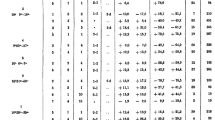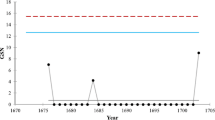Abstract
The Kanzelhöhe Observatory (KSO) was founded during World War II by the Deutsche Luftwaffe (German Airforce) as one station of a network of observatories that were set up to provide information on solar activity in order to better assess the actual conditions of the Earth’s ionosphere in terms of radio-wave propagation. Solar observations began in 1943 with photographs of the photosphere and drawings of sunspots, plage regions, and faculae, as well as patrol observations of the solar corona. At the beginning, all data were sent to Freiburg (Germany). After WW II, international cooperation was established and the data were sent to Zurich, Paris, Moscow, and Greenwich. Relative sunspot numbers have been derived since 1944. The agreement between relative sunspot numbers derived at KSO and the new International Sunspot Number (ISN) (SILSO World Data Center in International Sunspot Number Monthly Bulletin and online catalogue, 1945 – 2015) lies within \({\approx}\,10~\%\). However, revisiting the historical data, we also find periods with larger deviations. The reasons for the deviations were twofold: On the one hand, a major instrumental change took place during which the instrument was relocated and modified. On the other hand, a period of frequent replacements of personnel caused significant deviations; this clearly shows the importance of experienced observers. In the long term, the instrumental improvements led to better image quality. Additionally, we find a long-term trend towards better seeing conditions that began in 2000.















Similar content being viewed by others
Notes
NCEI, the world’s largest active archive of environmental data, was established in 2015 by the merger of the National Climatic Data Center (NCDC), the National Geophysical Data Center (NGDC), and the National Oceanographic Data Center (NODC).
References
Auer, I., Böhm, R., Jurkovic, A., Lipa, W., Orlik, A., Potzmann, R., Schöner, W., Ungersböck, M., Matulla, C., Briffa, K., Jones, P., Efthymiadis, D., Brunetti, M., Nanni, T., Maugeri, M., Mercalli, L., Mestre, O., Moisselin, J.-M., Begert, M., Müller-Westermeier, G., Kveton, V., Bochnicek, O., Stastny, P., Lapin, M., Szalai, S., Szentimrey, T., Cegnar, T., Dolinar, M., Gajic-Capka, M., Zaninovic, K., Majstorovic, Z., Nieplova, E.: 2007, HISTALP – historical instrumental climatological surface time series of the Greater Alpine Region. Int. J. Climatol. 27, 17. DOI . ADS .
Cacciani, A., Moretti, P.F., Messerotti, M., Hanslmeier, A., Otruba, W., Pettauer, T.V.: 1999, The Magneto-Optical Filter at Kanzelhöhe. In: Hanslmeier, A., Messerotti, M. (eds.) Motions in the Solar Atmosphere, Astrophys. Space Science Lib. 239, 271. ADS .
Clette, F., Svalgaard, L., Vaquero, J.M., Cliver, E.W.: 2014, Revisiting the sunspot number. A 400-year perspective on the solar cycle. Space Sci. Rev. 186, 35. DOI . ADS .
Comper, W.: 1958, Die eruptive Protuberanz vom 16. Dezember 1956. Mit 9 Textabbildungen. Z. Astrophys. 45, 83. ADS .
Comper, W., Kern, R.: 1957, Die Eruption (Flare) und der Protuberanzenaufstieg vom 4. Juni 1956. Mit 4 Textabbildungen. Z. Astrophys. 43, 20. ADS .
Dellinger, J.H.: 1935, A new cosmic phenomenon. Science 82, 351. DOI . ADS .
Eckel, O., Lauscher, F.: 1937, Vom Klima der Kanzelhöhe. Carinthia II 127, 1.
Greenwich Royal Observatory: 1947, Report of the proceedings of the Greenwich Royal Observatory. Mon. Not. Roy. Astron. Soc. 107, 62. ADS .
Hanslmeier, A., Otruba, W., Pötzi, W.: 2003, New H\(\alpha\) instrumentation at the Kanzelhöhe Solar Observatory. In: Wilson, A. (ed.) Solar Variability as an Input to the Earth’s Environment, SP-535, ESA, Noordwijk, 729. ADS .
Haupt, H.: 1965, Die Qualität der Sonnenbeobachtungen auf der Kanzelhöhe in Abhängigkeit von der Großwetterlage. Carinthia II 24, 290.
Haupt, H.: 1971, Astronomisches Institut (Universitäts-Sternwarte). I. Universitäts-Sternwarte Graz. Report 1969 – 1970. II. Sonnenobservatorium Kanzelhöhe. Report 1963-1970. Mitt. Astron. Ges. Hamb. 29, 62. ADS .
Haupt, H., Ellerböck, W., Kern, R.: 1959, Die Abhängigkeit der am Sonnenobservatorium Kanzelhöhe beobachteten Sonnenfleckenrelativzahlen von Luftgüte und Klassifizierung. Anz. Math.-Nat.wiss. Kl. Österr. Akad. Wiss. 12, 237.
Hirtenfellner-Polanec, W., Temmer, M., Pötzi, W., Freislich, H., Veronig, A.M., Hanslmeier, A.: 2011, Implementation of a Calcium telescope at Kanzelhöhe Observatory (KSO). Cent. Eur. Astrophys. Bull. 35, 205. ADS .
Hoyt, D.V., Schatten, K.H.: 1998a, Group sunspot numbers: a new solar activity reconstruction. Solar Phys. 179, 189. DOI . ADS .
Hoyt, D.V., Schatten, K.H.: 1998b, Group sunspot numbers: a new solar activity reconstruction. Solar Phys. 181, 491. DOI . ADS .
Jungmeier, G.: 2014, “... für eine dauernde Überwachung der Vorgänge auf der Sonne zum Zwecke der Funkberatung ...”. kso.ac.at/praesentation/fuer_eine_dauernde_ueberwachung.pdf . Accessed: 2015-12-07.
Jungmeier, G., Veronig, A., Pötzi, W.: 2014, Sonnenforschung auf der Kanzelhöhe. Sterne und Weltraum. 8, 2014
Kiepenheuer, K.O.: 1946, Internal Communications. Archives of the Kanzelhöhe Observatory, internal.
Kiepenheuer, K.O.: 1964, Solar site testing. In: Rosch, J. (ed.) Le Choix des Sites d’Observatoires Astronomiques (Site Testing), IAU Symp. 19, Gauthier-Villars, Paris, 193. ADS .
KSO: 1946 – 2000, Tätigkeitsberichte des Observatoriums Kanzelhöhe. Archives of the Kanzelhöhe Observatory, internal.
Kuiper, G.P.: 1946, German astronomy during the war. Pop. Astron. 54, 263. ADS .
Mathias, O.: 1962, Das Sonnenobservatorium der Universität Graz auf der Kanzelhöhe (Tätigkeitsbericht für die Jahre 1946 bis 1962). Anzeiger der Math.-naturwiss. Klasse der Österr. Akademie der Wissenschaften, Vienna 232.
Otruba, W.: 1993, Sky Darkening in Central Europe due to the Pinatubo Eruption. Anzeiger der Math.-naturwiss. Klasse der Österr. Akademie der Wissenschaften 130.
Pettauer, T.: 1990, The Kanzelhöhe photoheliograph. Publ. Debr. Heliophys. Obs., Heliogr. Ser. 7, 62. ADS .
Pötzi, W.: 2008, Scanning the old H-alpha films at Kanzelhöhe. Cent. Eur. Astrophys. Bull. 32, 9. ADS .
Pötzi, W.: 2010, Digitizing the KSO white light images. Cent. Eur. Astrophys. Bull. 34, 1. ADS .
Pötzi, W., Hirtenfellner-Polanec, W., Temmer, M.: 2013, The Kanzelhöhe online data archive. Cent. Eur. Astrophys. Bull. 37, 655. ADS .
Pötzi, W., Veronig, A.M., Riegler, G., Amerstorfer, U., Pock, T., Temmer, M., Polanec, W., Baumgartner, D.J.: 2015, Real-time flare detection in ground-based H\(\alpha\) imaging at Kanzelhöhe observatory. Solar Phys. 290, 951. DOI . ADS .
Rybák, J., Gömöry, P., Mačura, R., Kučera, A., Rušin, V., Pötzi, W., Baumgartner, D., Hanslmeier, A., Veronig, A., Temmer, M.: 2011, The LSO/KSO H\(\alpha\) prominence catalogue: cross-calibration of data. Contrib. Astron. Obs. Skaln. Pleso 41, 133. ADS .
Schroll, A.: 1979, Neubestimmung der Reduktionsfaktoren für die Sonnenfleckenbeobachtungen des Sonnenobservatoriums Kanzelhöhe. Sitz.ber. - Österr. Akad. Wiss. Math.-Nat.wiss. Kl., II Math. Astron. Phys. Meteorol. Tech. 188, 256.
Seiler, M.P.: 2007, Covert Operation “Sun God” – History of German Solar Research in the Third Reich and Under Allied Occupation (German Title: Kommandosache “Sonnengott” – Geschichte der deutschen Sonnenforschung im Dritten Reich und unter alliierter Besatzung). Acta Historica Astronomiae 31. ADS .
Shapley, A.H.: 1949, Reduction of sunspot-number observations. Publ. Astron. Soc. Pac. 61, 13. DOI . ADS .
Siedentopf, H.: 1940, Ein Spektrohelioskop mit Konkavgitter. Mit 1 Abbildung. Z. Astrophys. 19, 154. ADS .
SILSO World Data Center: 1945 – 2015, The International Sunspot Number. International Sunspot Number Monthly Bulletin and online catalogue. www.sidc.be/silso/ .
Steinegger, M., Denker, C., Goode, P.R., Marquette, W.H., Varsik, J., Wang, H., Otruba, W., Freislich, H., Hanslmeier, A., Luo, G., Chen, D., Zhang, Q.: 2000, The new global high-resolution H\(\alpha\) network: first observations and first results. In: Wilson, A. (ed.) The Solar Cycle and Terrestrial Climate, Solar and Space Weather, SP-463, ESA, Noordwijk, 617. ADS .
Svalgaard, L., Schatten, K.H.: 2016, Reconstruction of the Sunspot Group Number: the Backbone Method. Solar Phys. DOI . ADS .
Waldmeier, M.: 1955, Ergebnisse und Probleme der Sonnenforschung. Geest & Portig, Leipzig. ADS .
Waldmeier, M.: 1961, The Sunspot-Activity in the Years 1610 – 1960. Verlag Schulthess u. Co. AG, H. Künzel, Zurich. ADS .
Acknowledgements
Many pieces of information about historical and instrumental details were not available in printed or written form. We are grateful to Hermann Haupt and Thomas Pettauer, who have shaped the observatory through their work since the early 1950s and 1960s, respectively, for all of the information that they provided us through private communications that would otherwise have been lost.
Author information
Authors and Affiliations
Corresponding author
Ethics declarations
Disclosure of Potential Conflicts of Interest
The authors declare that they have no conflicts of interest.
Additional information
Sunspot Number Recalibration
Guest Editors: F. Clette, E.W. Cliver, L. Lefèvre, J.M. Vaquero, and L. Svalgaard
Rights and permissions
About this article
Cite this article
Pötzi, W., Veronig, A.M., Temmer, M. et al. 70 Years of Sunspot Observations at the Kanzelhöhe Observatory: Systematic Study of Parameters Affecting the Derivation of the Relative Sunspot Number. Sol Phys 291, 3103–3122 (2016). https://doi.org/10.1007/s11207-016-0857-6
Received:
Accepted:
Published:
Issue Date:
DOI: https://doi.org/10.1007/s11207-016-0857-6




